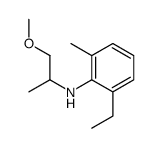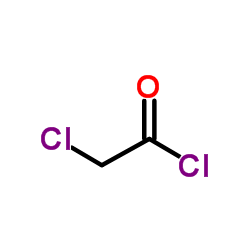metolachlor [ANSI, WSSA]
![metolachlor [ANSI, WSSA] Structure](https://image.chemsrc.com/caspic/210/51218-45-2.png)
metolachlor [ANSI, WSSA] structure
|
Common Name | metolachlor [ANSI, WSSA] | ||
|---|---|---|---|---|
| CAS Number | 51218-45-2 | Molecular Weight | 283.794 | |
| Density | 1.1±0.1 g/cm3 | Boiling Point | 406.8±45.0 °C at 760 mmHg | |
| Molecular Formula | C15H22ClNO2 | Melting Point | -62.1 °C | |
| MSDS | Chinese USA | Flash Point | 199.8±28.7 °C | |
| Symbol |

GHS07 |
Signal Word | Warning | |
Use of metolachlor [ANSI, WSSA]Metolachlor is a pre-emergent selective, chloroacetanilide herbicide for the control of a variety of annual grass and broad leaf weeds in corn and other crops. Metolachlor is a chiral herbicide consisting of four stereoisomers[1][2]. |
| Name | metolachlor |
|---|---|
| Synonym | More Synonyms |
| Description | Metolachlor is a pre-emergent selective, chloroacetanilide herbicide for the control of a variety of annual grass and broad leaf weeds in corn and other crops. Metolachlor is a chiral herbicide consisting of four stereoisomers[1][2]. |
|---|---|
| Related Catalog | |
| References |
| Density | 1.1±0.1 g/cm3 |
|---|---|
| Boiling Point | 406.8±45.0 °C at 760 mmHg |
| Melting Point | -62.1 °C |
| Molecular Formula | C15H22ClNO2 |
| Molecular Weight | 283.794 |
| Flash Point | 199.8±28.7 °C |
| Exact Mass | 283.133911 |
| PSA | 29.54000 |
| LogP | 3.00 |
| Vapour Pressure | 0.0±0.9 mmHg at 25°C |
| Index of Refraction | 1.533 |
CHEMICAL IDENTIFICATION
HEALTH HAZARD DATAACUTE TOXICITY DATA
MUTATION DATA
|
|
~% ![metolachlor [ANSI, WSSA] Structure](https://image.chemsrc.com/caspic/210/51218-45-2.png)
metolachlor [AN... CAS#:51218-45-2 |
| Literature: Ciba-Geigy Corporation Patent: US4317916 A1, 1982 ; |
|
~% ![metolachlor [ANSI, WSSA] Structure](https://image.chemsrc.com/caspic/210/51218-45-2.png)
metolachlor [AN... CAS#:51218-45-2 |
| Literature: Ciba-Geigy Patent: CH581607 , 1976 ; Chem.Abstr., 1977 , vol. 86, # 72242 |
| HS Code | 2924299017 |
|---|---|
| Summary | 2924299017 2-chloro-n-(2-ethyl-6-methylphenyl)-n-(1-methoxypropan-2-yl)acetamide。supervision conditions:s(import or export registration certificate for pesticides)。VAT:17.0%。tax rebate rate:9.0%。MFN tarrif:6.5%。general tariff:30.0% |
|
Embryotoxic and genotoxic effects of heavy metals and pesticides on early life stages of Pacific oyster (Crassostrea gigas).
Mar. Pollut. Bull. 64(12) , 2663-70, (2012) This study evaluated embryotoxicity and genotoxicity of two dissolved metals copper and cadmium (Cu and Cd) and two pesticides (metolachlor and irgarol) occurring in Arcachon Bay (SW France) in Pacifi... |
|
|
Polar organic chemical integrative samplers for pesticides monitoring: impacts of field exposure conditions.
Sci. Total Environ. 488-489 , 188-96, (2014) This study focuses on how Polar Organic Chemical Integrative Samplers (POCIS) work in real environmental conditions. A selection of 23 polar pesticides and 8 metabolites were investigated by exposure ... |
|
|
Biodegradation of the acetanilide herbicides alachlor, metolachlor, and propachlor.
Crit. Rev. Microbiol 24(1) , 1-22, (1998) Alachlor, metolachlor, and propachlor are detoxified in biological systems by the formation of glutathione-acetanilide conjugates. This conjugation is mediated by glutathione-S-transferase, which is p... |
| 2-Chloro-N-(2-ethyl-6-methylphenyl)-N-(2-methoxy-1-methylethyl)acetamide |
| Cotoran multi |
| 2-Chloro-6'-ethyl-N-(2-methoxy-1-methylethyl)acet-o-toluidide |
| 2R C1 BNV1GY1&1O1 |
| 2-chloro-N-(6-ethyl-o-tolyl)-N-[(1RS)-2-methoxy-1-methylethyl]acetamide |
| Primagram |
| 2-chloro-6’-ethyl-N-[(1RS)-2-methoxy-1-methylethyl]acet-o-toluidide |
| Metolachlor |
| Bicep |
| Primextra |
| EINECS 257-060-8 |
| Acetamide, 2-chloro-N-(2-ethyl-6-methylphenyl)-N-(2-methoxy-1-methylethyl)- |
| 2-Chloro-N-(2-ethyl-6-methylphenyl)-N-(1-methoxypropan-2-yl)acetamide |
| 2-Chloro-N-(2-ethyl-6-methylphenyl)-N-(-2-methoxy-1-methylethyl)acetamide |
| rac-2-chloro-N-(2-ethyl-6-methylphenyl)-N-[(2R)-1-methoxypropan-2-yl]acetamide |
| MFCD00055293 |
| α-Chloro-2'-ethyl-6'-methyl-N-(1-methyl-2-methoxyethyl)acetanilide |
| 2-Chloro-N-(2-ethyl-6-methylphenyl)-N-(1-methoxy-2-propanyl)acetamide |



 CAS#:65513-61-3
CAS#:65513-61-3
